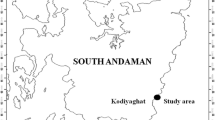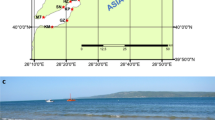Abstract
Total meiofauna abundance was estimated to be 4.7×106 individuals m-2 in a sublittoral soft bottom when sampled by SCUBA diving in the Øresund. Nematode abundance was 4.5×106 (equal to 1.4 g organic carbon), harpacticoid copepods 148×103, kinorhynchs 45×103 and ostracods 28×103·m-2. Three main groups of metabolic types are proposed. Almost all harpacticoid copepods, kinorhynchs and ostracods were found in the uppermost flocculent bottom layer and among the nematodes the non-selective detritus feeding species dominated; nematodes in this layer were mainly small. Epistrate feeding nematodes dominated between 1 and 4 cm depth; the size of nematodes varied greatly (less than 0.1 μl and up to 65 μl) with a mean body volume of 2.6 to 3.7 μl. Non-selective deposit feeding nematodes dominated totally deeper than 4-cm depth, i.e. in and below the redox-potential-discontinuity (RPD) layer. They were of median size and in species composition different from those above 4-cm depth. Haps corer samples underestimated nematode and harpacticoid copepod numbers in the top cm; the abundances were 66 and 48% respectively of those obtained by divers. Therefore, this sampling gear cannot be recommended for meiofauna studies on muddy bottoms covered with a flocculent detritus layer.
Similar content being viewed by others
Literature cited
Andrassy, I.: Die Rauminhalts und Gewichtsbestimmung der Fadenwürmer (Nematoden). Acta zool. Hung. 11, 1–5 (1956)
Ankar, S. and R. Elmgren: The benthic macro-and meiofauna of the Askö—Landsort Area (Northern Baltic Proper). A stratified random sampling survey. Contr. Askö Lab. 11, 1–115 (1976)
Arlt, G.: Vertical and horizontal microdistribution of the meiofauna in the Greifswalder Bodden. Oikos suppl. 15, 105–111 (1973)
Boucher, G.: Distribution quantitative et qualitative des nématodes todes d'une station de vase terrigene côtière de Banyuls-sur-Mer Cah. Biol. Mar. 13, 457–474 (1972)
Boucher, G.: Premières données écologiques sur les nématodés libres marins d'une station de vase côtière de Banyuls. Vie et Milieu 23 (1B), 69–100 (1973)
Coull, B. C., G. F. R. Hicks and J. B. J. Wells: nematode/copepod ratios for monitoring pollution: A rebuttal. Mar. Pollut. Bull. 12, 378–381 (1981)
Edmonson, W. T. and G. G. Winberg (eds): A manual on methods for the assessment of secondary productivity in fresh waters, 358 pp. IBP Handbook No. 17. Oxford and Edinburgh 1971
Elmgren, R.: Methods for sampling sublittoral soft bottom meiofauna. Oikos suppl. 15, 112–120 (1973)
Findlay, S. and Tenore, K. R.: Effect of a free-living marine nematode (Diplolaimella chitwoodi) on detrital carbon mineralization. Mar. Ecol. Prog. Ser. 8, 161–166 (1982)
Gerlach, S. A.: On the importance of marine meiofauna for benthos communities. Oecologia 6, 176–190 (1971)
Gerlach, S. A.: Food-chain relationships in subtidal silty sand marine sediments and the role of meiofauna in stimulating bacterial productivity. Oecologia 33, 55–69 (1978)
Gerlach, S. A. and M. Schrage: Life cycles in marine meiobenthos. Experiments at various temperatures with Monhystera disjuncta and Theristus pertenuis. Mar. Biol. 9, 274–280 (1971)
Gray, J. S.: The ecology of marine sediments, 185 pp. Cambridge: Cambridge Univ. Press 1981
Hakala, I.: A new model of the Kajak bottom sampler, and other improvements in the zoobenthos sampling technique. Ann. Zool. Fennici 8, 422–426 (1971)
Holme, N. A. and A. D. McIntyre (eds): Methods for the study of marine benthos, 334 pp. IBP Handbrook No. 16. Oxford and Edinburgh 1971
Holopainen, I. J. and J. Sarvala: Efficiencies of two corers in sampling soft-bottom invertebrates. Ann. Zool. Fennici 12, 280–284 (1975)
Jensen, K.: Comparison of two bottom samplers for benthos monitoring. Env. Techn. Letters 2, 81–84 (1981)
Jensen, P.: Nematodes from the Øresund, Denmark. Spatial distribution patterns and determination of sample size. Proc. 3rd int. Meiofauna Conf. Hamburg, Aug. 1977 (Abstract) 1977
Jensen, P.: Four nematoda Araeolaimida from the Øresund with remarks on the oesophageal structures in Aegialoalaimus. Cah. Biol. Mar. 19, 221–231 (1978a)
Jensen, P.: Revision of Microlaimidae, erection of Molgolaimidae fam. n., and remarks on the systematic position of Paramicrolaimus (Nematoda, Desmodorida). Zool. Scr. 7, 159–173 (1978b)
Jensen, P.: Revision of Comesomatidae (Nematoda). Zool. Scr. 8, 81–105 (1979)
Jensen, P.: Species, distribution and a microhabitat theory for marine mud dwelling Comesomatidae (Nematoda) in European waters. Cah. Biol. Mar. 22, 231–241 (1981)
Jensen, P.: Ecology of benthic and epiphytic nematodes. Hydrobiologia (In press)
Jensen, P.: Reproductive ecology and carbon production of the free-living marine nematode Chromadorita tenuis (in preparation)
Juario, J. V.: Neue freilebende Nematoden aus dem sublittoral der Deutschen Bucht. Veröff. Inst. Meeresforsch. Bremerh. 14, 275–303 (1974)
Juario, J. V.: Nematode species composition and seasonal fluctuation of a sublittoral meiofauna community in the German Bight. Veröff. Inst. Meeresforsch. Bremerh. 15, 283–337 (1975)
Kajak, Z.: Analysis of quantitative benthic methods. Ekologia Polska (A) 11, 1–56 (1963)
Kanneworff, E. and W. Nicolaisen: The “Haps”. A frame-supported bottom corer. Ophelia 10, 119–129 (1973)
Keynäs, K. and L. Keynäs: Meiofauna in soft bottom sediments at Tvärminne, northern Baltic. Methods and preliminary results. Mem. Soc. Fauna Flora Fenn. 54, 65–68 (1978)
Lorenzen, S.: Die Nematodenfauna im Verklappungsgebiet für Abwasser nordwestlich von Helgoland. I. Araeolaimida und Monhysterida. Zool. Anz. 187, 223–248 (1971)
McIntyre, A. D.: Deficiency of gravity corers for sampling meiobenthos and sediments. Nature, Lond. 321, 260 (1971)
Raffaelli, D. G.: Monitoring with meiofauna.—A reply to Coull. Hicks and Wells (1981) and additional data. Mar. Pollut. Bull. 12, 381–382 (1981)
Raffaelli, D. G. and C. F. Mason: Pollution monitoring with meiofauna, using the ratio of nematodes to copepods. Mar. Pollut. Bull. 12, 158–163 (1981)
Scheibel, W.: Submarine experiments on benthic colonization of sediments in the western Baltic Sea. I. Technical layout. Mar. Biol. 28, 159–164 (1974)
Scheibel, W.: Quantitative Untersuchungen am Meiobenthos eines Profils unterschiedlicher Sedimente in der westlichen Ostsee. Helgol. wiss. Meeresunters. 28, 305–312 (1976)
Scheibel, W. and H. Rumohr: Meiofaunaentwicklung auf künstlichen Weichböden in der Kieler Bucht. Helgol. wiss. Meeresunters. 32, 305–312 (1979)
Soyer, J.: Bionomie benthique du plateau continental de la côte catalane français. 3 Les peuplements de Copépodes Harpacticoides (Crustacea). Vie et Milieu 21 (1B), 337–551 (1970)
Thorson, G.: Bottom communities. In: Treatise on marine ecology and palecology. Ed. by J. W. Hedgeperth, Geol. Soc. Amer. Mem. 67, 461–534 (1957)
Vrancken, G., L. K. Thielemans, C. Heip and M. Vandycke: Aspects of the life cycle of Monhystera parelegantula (Nematoda, Monhysteridae). Mar. Ecol. Prog. Ser. 6, 67–72 (1981)
Warwick, R. M.: The nematode/copepod ratio and its use in pollution ecology. Mar. Pollut. Bull. 12, 329–333 (1981a)
Warwick, R. M.: The influence of temperature and salinity on energy partitioning in the marine nematode Diplolaimelloides bruciei. Oecologia 51, 318–325 (1981b)
Warwick, R. M. and J. B. Buchanan: The meiofauna off the coast of Northumberland. I. The structure of the nematode population. J. mar. biol. Ass. U.K. 50, 129–146 (1970)
Wieser, W.: Die Beziehung zwischen Mundhöhlengestalt, Ernährungsweise und Vorkommen bei freilebenden marinen Nematoden. Ark. Zool. (Ser. 2) 4, 439–484 (1953)
Wieser, W.: Benthic studies in Buzzard Bay. II. The meiofauna. Limnol. Oceanogr. 5, 121–137 (1960)
Author information
Authors and Affiliations
Additional information
Communicated by T. Fenchel, Aarhus
Rights and permissions
About this article
Cite this article
Jensen, P. Meiofaunal abundance and vertical zonation in a sublittoral soft bottom, with a test of the Haps corer. Mar. Biol. 74, 319–326 (1983). https://doi.org/10.1007/BF00403458
Accepted:
Issue Date:
DOI: https://doi.org/10.1007/BF00403458




